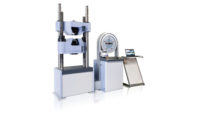
A fractured surface of a plastic using SEM/EDS analysis is shown here. Source: McCrone Associates
Conducting successful microanalytical materials testing, however, requires specialized technical skills and state- of-the-art analytical instrumentation that in-house quality control laboratories typically do not possess. In these cases, many materials manufacturers look to independent laboratories with the necessary skills and instrumentation for help.
Benefits
One of the advantages is that the entire sample does not need to be sacrificed. Although some techniques can look at samples in situ, others may require that very small amounts of material be removed from the sample and mounted on special substrates for analysis. Microanalytical techniques typically require solid samples with volumes of less than 1×10-5 mm³, which is much smaller than the naked eye can see. The nondestructive value of this testing is especially important for rare or expensive materials, materials involved in litigation disputes, one-of-a-kind samples such as a prototype, or samples of a limited supply, such as the reverse engineering of a competitor’s product.First Look
Upon receipt of the materials, laboratories first perform a visual inspection followed by inspection with a stereomicroscope. This first look provides vital information about the samples and may even lead to a quick determination of the problem. External visual defects such as streaks, inclusions, opacity and particulate contaminants can be quickly observed and characterized.Scientists also can examine the sample structure by sectioning very thin layers and studying the morphology of the sample-looking for the presence or absence of crystalline regions, or the type and distribution of fillers or other particulates in the material. For example, a plastic product that lacks rigidity or displays cracking problems may contain unevenly dispersed fillers, or an amount or type of filler different than specified.
After the initial visual inspection is complete, the material is usually subjected to additional testing to obtain more detailed information about the material in question.

Transmission electron microscopy (TEM) can examine materials or contaminants in the nanometer size range. Source: McCrone Associates
Techniques
In addition to the light microscope, the two most commonly used analytical techniques for materials analysis are infrared spectroscopy (FTIR or micro-FTIR) and scanning electron microscopy (SEM) combined with an energy dispersive X-ray spectrometer (EDS) detector.In infrared analysis, the sample is exposed to a beam of infrared radiation that contains multiple frequencies of light. Every substance absorbs light at different frequencies and produces a unique infrared spectrum, producing a chemical fingerprint of the material. The infrared spectrum is compared to published or reference spectra to identify the material.
In some cases, the infrared analysis can be performed nondestructively by reflecting the beam of infrared radiation off the sample surface. In other cases, a small shaving of the sample, less than 0.05 millimeter in size, is pressed into a thin, transparent film for analysis. Although micro-FTIR analyses require some alteration of the original sample, the specimen removed from the original sample is not destroyed and can be preserved for future tests.
In SEM/EDS analysis, the sample is exposed to a focused electron beam. Interactions between the electron beam and atoms in the sample produce electron signals used for imaging and X-rays used for chemical analysis. The high-quality image shows the sample’s surface at submicron resolution and the X-ray shows the elements present in the near surface region. SEM/EDS is commonly used to identify inorganic materials such as metals, glass fragments and minerals, but also can characterize certain organic materials. SEM/EDS has been used to examine fractured surfaces, multilayered samples and to look for defects. In larger samples SEM/EDS also can determine particle sizes, shapes and distribution.
Other Useful Techniques
X-ray photoelectron spectroscopy (XPS), also known as ESCA or electron spectroscopy for chemical analysis, uses an X-ray beam to generate photoelectrons in the sample, which provide information about the outermost surface (~5 nanometers) of the material. XPS is more sensitive than EDS and is well suited for the analysis of thin surface layers and residues on solid samples. In addition, XPS can perform depth profiles to characterize underlying material or layer-by-layer analyses. XPS has been successfully used to measure surface oxidation due to UV exposure, surface chemistry changes after gamma irradiation, residual mold release agents and to study the migration of materials between the surface and interior of solid samples.Transmission electron microscopy (TEM) can examine materials or contaminants in the nanometer size range. This method is becoming more important as the use of nanomaterials becomes more common. Samples submitted for TEM analysis are milled or thin-sectioned to a final thickness of no more than 1 micron, to allow the penetration of electrons through the sample. TEM is an excellent technique for examining nanofiller distributions, crystalline structures and thin films.
In the production or manufacturing process, nondestructive testing both early and frequently is beneficial to manufacturers to ensure that raw materials meet specifications, to help reduce materials error and product failures and to identify contaminants that might be harmful to the final product.






